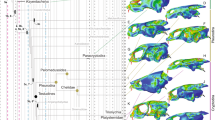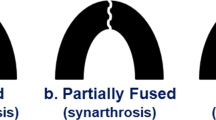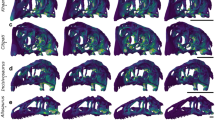Abstract
The morphology of the lizard skull has been a subject of study for more than a century, particularly with respect to the morphology and function of the major jaw adducting muscles1–5 and the mechanics of the moving parts6–9. It is possible that controversies surrounding the extent and timing of bone movement, muscle contraction and force generation will be resolved by techniques such as electromyography, cineradiography and measurement of bone strain3,10. I present here data that facilitate a reconsideration of the function of the pterygoideus muscle, one of the two major jaw adducting muscles, and the mechanical significance of movements of the quadrate around the quadrate-squamosal joint. This movement, known as streptostyly6 occurs in all living lizards11 and also characterises the earliest members of the order12–14. On the basis of my data I propose that streptostyly in lizards is a means by which the mechanical advantage of the pterygoideus muscle is increased, so that this muscle makes a major contribution to bite force.
This is a preview of subscription content, access via your institution
Access options
Subscribe to this journal
Receive 51 print issues and online access
$199.00 per year
only $3.90 per issue
Buy this article
- Purchase on Springer Link
- Instant access to full article PDF
Prices may be subject to local taxes which are calculated during checkout
Similar content being viewed by others
References
Lakjer, T. Studien uber die Trigeminus-versorgte Kaumusculature der Sauropsiden 1–154 (Rietzel, Copenhagen, 1926).
Haas, G. in Biology of the Reptilia (eds Gans, C. & Parson, T.) 4, 285–490 (Academic, New York, 1973).
Throckmorton, G. S. J. Morph. 148, 363–390 (1976); Anat. Rec. 190, 217–222 (1978).
Iordansky, N. N. Zool. Zh. 45, 1398–1410 (1966); Anat. Anz. 127, 383–413 (1970).
Gomes, N. M. B. & Gasc, J. P. Papies Avulsos Zool. 27, 1–25 (1973).
Versluys, J. Zool. Jahr. 30, 177–260 (1910); Zool. Jahr. Suppl. 15, 545–714 (1912).
Frazzetta, T. H. J. Morph. 111, 287–319 (1962).
Rieppel, O. Experientia 34, 776–777 (1978).
Gingerich, P. D. Postilla 152, 1–10 (1971).
Smith, K. K. Am. Zool 18, 623 (1978); Am. Zool. 19, 1012 (1979).
Camp, C. L. Bull. Am. Mus. nat. Hist. 48, 289–481 (1923).
Robinson, P. L. Colloques int. Cent. natn. Rech. Scient. 163, 395–407 (1967); J. geol. Soc. Lond. 129, 457–479 (1973).
Colbert, E. H. Bull. Am. Mus. nat. Hist. 143, 81–142 (1970).
Carroll, R. L. Palaeont. afr. 18, 71–87 (1975); in Problems in Vertebrate Evolution (eds Andrews, A. M., Miles, R. S. & Walker, A. D.) 359–396 (Linnean Society, London, 1976).
Jenkins Jr, F. A. & Weijs, W. A. J. Zool., Lond. 188, 379–410 (1979).
Hylander, W. L. Am. J. Phys. Anth. 46, 309–326 (1977).
Author information
Authors and Affiliations
Rights and permissions
About this article
Cite this article
Smith, K. Mechanical significance of streptostyly in lizards. Nature 283, 778–779 (1980). https://doi.org/10.1038/283778a0
Received:
Accepted:
Issue Date:
DOI: https://doi.org/10.1038/283778a0
Comments
By submitting a comment you agree to abide by our Terms and Community Guidelines. If you find something abusive or that does not comply with our terms or guidelines please flag it as inappropriate.



